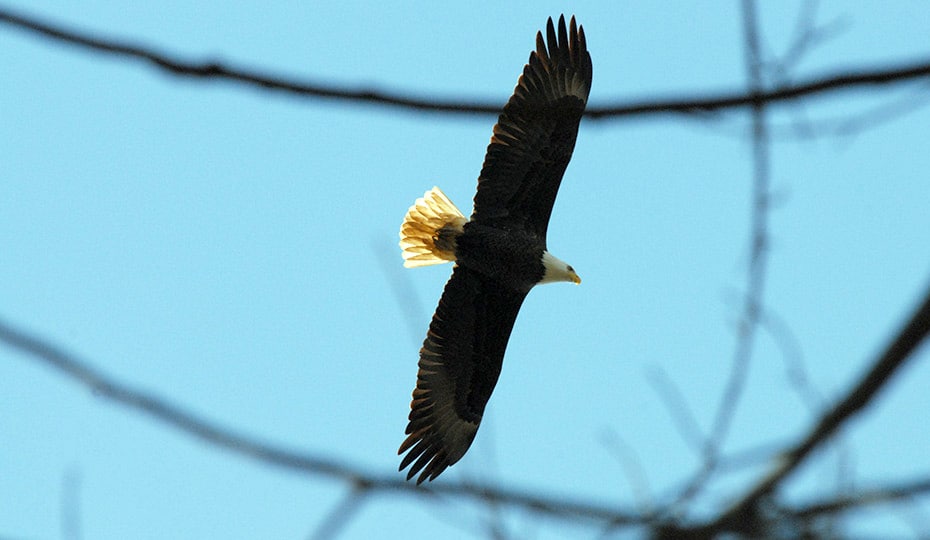Share this article
Soaring with eagles to protect their habitat
As a Duke Energy helicopter hovered 500 feet over a bald eagle nest near Lake James, North Carolina, environmental scientist Misti Sporer peered through her binoculars.
“Oooh, I’m seeing one very small fluffy thing!” she told the pilot. “Stay here, don’t get any closer.”
Sporer can be excused for back-seat driving — protecting bald eagles is one of the most important parts of her job. She quickly took notes, sharing her discovery with the others on board: “One chick, one egg, one adult.”
From up front, environmental scientist Will Ricks logged coordinates, which will be included in the report Duke Energy produces for state and federal wildlife officials.

The helicopter peeled off within 30 seconds. “Mama bird was getting agitated, we don’t want her unhappy,” Sporer said. When the eagle starts ruffling wings and glaring at her visitors from one eye and then the other, it’s time to move on.
As certified wildlife biologists, Ricks and Sporer are permitted to observe eagles inside the 1,000-foot aerial buffer. They were conducting Duke Energy’s annual eagle survey, which began in 2016 when the company renewed its federal license for 13 hydroelectric stations in the Catawba-Wateree River basin.
Birdwatching is not an activity most people associate with late winter, but that’s prime time for Duke Energy’s team of environmental scientists. Eagles are easiest to spot when they’re nesting and before deciduous trees begin to leaf out.
No longer endangered, but protected
While bald eagles were removed from the federal list of threatened and endangered species in 2007, they remain covered by the Bald and Golden Eagle Protection Act.
This year’s aerial survey was a three-day tour along the Catawba and Yadkin rivers. Sporer and Ricks found 35 bald eagles on the first day, a 110-mile flight from Lake Wateree in South Carolina to the southern edge of Lake Norman north of Charlotte, North Carolina. On day two, they saw seven eagles from Lake Norman up to Lake James, while the team sighted 23 eagles on their final run, from Lake Tillery to Blewett Falls Lake in the Yadkin-Pee Dee River basin in North Carolina.
On Lake Norman, the day’s first eagle nest was identified less than a mile from Marshall Steam Station, at the top of a pine facing the power plant. Spotted shortly after 9 a.m., the female was nesting on one egg while the male was away, likely out hunting. Females typically don’t leave the nest until temperatures rise above 55 degrees.
This nest sits on a company-owned peninsula visible from North Carolina Highway 150, behind a submerged wall that separates the public lake from cooler waters near the steam station intake channel. Beyond protecting the forest immediately around the nest, Duke Energy also coordinates all activity on Marshall’s adjacent parcels to ensure the birds remain undisturbed. Eagles have returned to this nest each year since 2016, after moving from across the cove when a nest was damaged during a storm.
Balancing environmental priorities
The aerial survey is far from the company’s lone method for monitoring eagles. In early March, Sporer visited Buck Steam Station before dawn to set up 50 feet from a nest beside the company’s coal ash basin. Given this nest’s proximity to company operations, Sporer studies its activity from the ground monthly from November to June.
Though the nest is not within the ash basin itself, observing the eagle’s behavior while construction takes place on a nearby coal ash reprocessing facility is a critical way Sporer ensures that one environmental priority – ash recycling – doesn’t adversely affect another.
Preserving habitat amid development
Aside from compiling reports for the U.S. Fish & Wildlife Service, North Carolina Wildlife Resource Commission and South Carolina Department of Natural Resources, Duke Energy also uses these eagle surveys to keep lake property owners informed of federally protected birds near their property.
“It ensures we don’t authorize lake neighbors to undertake activities that might disturb bald eagle nests,” said Steve Jester, Duke Energy vice president of water strategy, hydro licensing and lake services.
The eagles near Duke Energy facilities continue to thrive. For example, the nest beside Buck’s ash basin has hatched two chicks a year for at least eight years; long-time Buck employees believe eagles have nested there for decades. And the overall eagle count along the Catawba-Wateree basin has grown since aerial surveys began in 2016, from 26 that year to 42 in 2019. But the eagle population from Lake Norman to Lake James is lower than in other areas, primarily due to development.
“The rapid changes around Lake Norman and to the north are obvious when you’re tracking it year to year from the air,” said Sporer. “It’s amazing to see how many eagles are at the lower end of Lake Wateree, for example, and that’s partly because it’s the least-developed land along the 300 miles we survey in that river basin.”
State and federal wildlife officials count on Duke Energy’s annual survey to help them ensure developers don’t encroach on known habitats. Within the property Duke Energy owns or manages, maintaining awareness is the key.
“We know what eagles will tolerate and what has the potential to disturb their habitat, and we build that into our daily operations as well as long-term planning,” said Sporer. “My job is to make sure eagles get to keep doing eagle-y things.”
Header Image: Misti Sporer logs in an eagle sighting above Rhodhiss Lake near Granite Falls, North Carolina. ©Duke Energy








